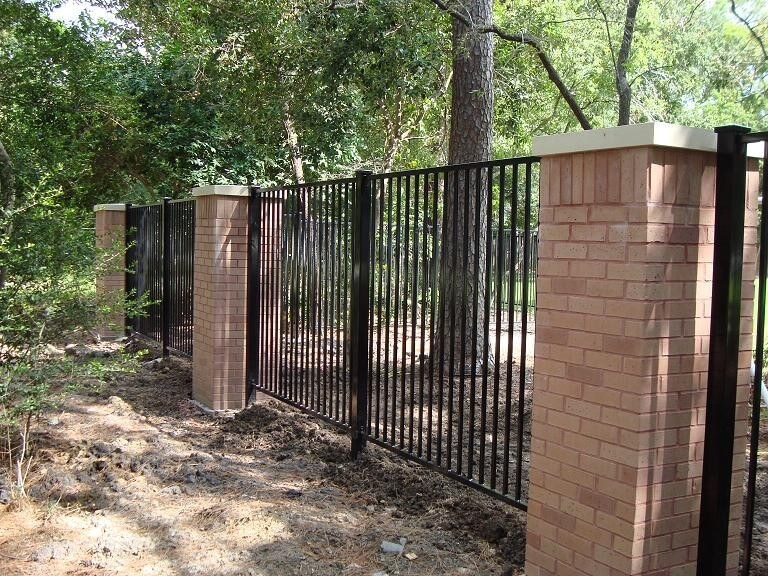Fence Building Using Multiple Materials – Amazing Looks
Incorporating multiple materials into fence building allows for both aesthetic appeal and functional diversity. For example, combining wood and iron can create a visually appealing yet sturdy barrier, while utilizing vinyl and brick can provide a balance of low maintenance and durability. This approach offers flexibility in design, customization, and long-term resilience to various environmental conditions.

Versatility of Fence Building Materials
When it comes to selecting the right material for your fence, you need to consider more than just its appearance. Each material offers unique benefits, allowing you to weigh the pros and cons based on your specific needs.
Wood: Wood fences have a timeless appeal, adding warmth and character to any property. The diverse range of wood types, such as cedar, pine, and redwood, grants you the flexibility to choose a style that complements the aesthetic of your home. However, it is important to remember that wood requires maintenance to prevent decay and rot. A good stain or paint application can significantly extend the lifespan of a wood fence.
Vinyl: Vinyl fences are known for their durability and low maintenance, making them an attractive choice for homeowners seeking a long-lasting solution without ongoing attention. They are resistant to rot, decay, and insect damage, making them an ideal option for those who prefer hassle-free care.
Metal: If security is a top priority, metal fences present a robust solution. Iron and aluminum fences offer superior strength and provide heightened protection against intrusion. Additionally, they require minimal maintenance while standing up well in various weather conditions. These fences are particularly popular among commercial property owners due to their strength and durability.
Chain Link: For a budget-friendly yet reliable option, chain link fences are favored. They come in various heights and gauges and are widely used in both residential and commercial settings. While they may not offer the same privacy as other types, they are highly customizable with options such as privacy slats and come in a variety of colors.
As you can see, each material serves different requirements. For example, if you prioritize aesthetics with minimal upkeep, vinyl or wood might be ideal for your home. On the other hand, if security is paramount, metal or chain link could be more suitable.
Understanding the unique attributes of each fence building material empowers you to make an informed decision tailored to your specific needs and preferences, ensuring that your fence not only looks great but also functions effectively for years to come.
Detailing Wood, Vinyl, Metal, and Chain Link Fences
Let’s begin with Wood Fences. Wood has a unique natural charm and can create a warm and inviting feel that complements diverse architectural styles. When it comes to design possibilities, the sky’s the limit! You can have it painted or stained in any color you like, and it’s versatile enough to blend into any landscape.
However, there’s a trade-off. Wood fences require regular maintenance. They must be sealed and stained every couple of years to protect them from the elements and keep them looking nice. In essence, wood fences demand dedication—so if you’re willing to roll up your sleeves for periodic upkeep, then wood might be perfect for you.
Moving on to Vinyl Fences, they’re like the low-maintenance superheroes of the fence world. They come in a variety of styles and colors and are impervious to rot or pests. Imagine the freedom from scraping, staining, or reapplying sealant – all of which you’d have to do with a wood fence!
Metal fences are next on our list. These fences boast durability. They’re strong and secure while offering various decorative options for those who value aesthetics. That being said, without proper coating, metal fences are prone to rust. Weather conditions can impact these fences over time.
Now let’s discuss Chain Link Fences, known for their affordability. If you need a cost-effective option yet still want security, this could be for you. Chain link fences offer high visibility which can be beneficial when surveillance is important. However, they do have limited privacy capabilities due to the gaps between the links.
Each material has its own pros and cons, so think carefully about what will work best for your lifestyle and budget. Remember that making an informed decision now means fewer problems down the road!
Even though each material has its unique characteristics—wood’s natural aesthetic appeal, vinyl’s low maintenance requirements, metal’s durability, or chain link’s affordability—always choose based on practicality and your specific needs.
Key Considerations in Selecting Material
Imagine each fence material has its unique personality; the key is finding the one that matches the values and needs of your home. Our team has seen it all across countless properties in Houston, and we can tell you that matching a fence to its purpose isn’t always straightforward; it requires consideration of various important factors.
First off, consider the primary purpose of the fence. If you’re looking for privacy around your property, something like wood might be suitable for its solid appearance. On the other hand, if security is key, metal or stone might be more effective. Having a clear understanding of what you need from the fence will guide your decision and ensure that your material choice aligns with your goals and expectations.
Property style is also a huge factor that many homeowners overlook when choosing a fence material. Just like how we choose our clothes to complement our body shape and personal style, your fence should complement the architectural style of your home and add to its visual appeal rather than detract from it. For instance, stately brick homes might best be paired with iron or brick fences, while more modern homes often look best with sleek vinyl or aluminum options.
When selecting a fence building material, it’s crucial to assess the maintenance level too. Some materials like wood require regular staining and sealing to maintain their color and integrity, while others like vinyl are basically maintenance-free once they’re installed. The cost of maintaining your fence is another consideration—if you’re not keen on spending weekends on upkeep or hiring a professional service for cleaning and repairs, it’s wise to opt for a low-maintenance material that suits your budget as well.
For example, I had a client who was set on installing a wood fence due to its natural beauty, but after considering his busy schedule and minimal interest in ongoing maintenance, he realized that vinyl would be a better fit in terms of longevity and minimal upkeep.
By thoughtfully evaluating these fundamental factors: the purpose of the fence, property style, and maintenance level – you’ll be better equipped to choose the most practical and aesthetically pleasing material for your new fence. Our experience working with different materials has shown us time and again that considering these elements is crucial in ensuring both short-term satisfaction and long-term functionality for any fence project.
Cost, Durability, and Weather Resistance of Fencing Materials
When selecting the right fence building material for your property, cost, durability, and weather resistance play a critical role. It’s essential to delve deeper into these factors to make an informed decision that meets your specific needs.
Wood Fences
Wood is favored for its rustic and natural look, lending a warm aesthetic to any property. Despite its relatively low initial cost compared to other materials, long-term expenses like regular maintenance must be taken into account. Without proper care such as staining or sealing every few years, wood fences are susceptible to rot, warping, and damage from pests. However, wood remains a sought-after choice due to its timeless charm.
Vinyl Fences
Vinyl fencing has gained popularity due to its minimal maintenance requirements. Although the initial investment may be higher than that of wood or chain link fences, the long-term savings from reduced maintenance costs often balance out this difference. Offering a vast array of styles and colors, vinyl provides an attractive and durable option for fences that stand strong against weather elements.
Metal Fences
Metal fences are prized for their superior durability and weather resistance. Aluminum and steel fences are resistant to corrosion, making them ideal for areas with high humidity or coastal locations. While the upfront cost may be higher compared to wood or chain link options, metal fences stand the test of time with minimal wear and tear.
Chain Link Fences
Chain link fences offer an affordable solution with moderate durability and minimal vulnerability to weather elements. Although they may not provide the same level of privacy as wood or vinyl fences, their low cost and resilience against weather conditions make them an appealing option for many property owners.
Considering the costs, durability, and weather resistance of each fencing material is crucial in making an informed decision that aligns with your budget and long-term maintenance goals.
Guidance for Fence Installation
Constructing a fence on your property can be an exciting and empowering project. It’s a chance to improve the look of your home, increase privacy, and provide security. But, it’s crucial to plan methodically, adhere to local regulations, and follow necessary steps to ensure your fence is installed safely and securely.
The first step in your DIY fencing venture should always involve researching local regulations. Every city and town has its own set of rules and guidelines when it comes to building fences. It’s crucial to check with local authorities to ensure that you comply with building codes, know the property lines to avoid encroachment, and find out if any permits are required before starting construction. Failure to comply might lead to fines or even having to remove the fence altogether. This step is essential before investing time and resources into your project.
Once you’ve familiarized yourself with the local regulations, it’s time to prepare the site. Clearing the area where the fence will be installed is important; this includes removing any debris or obstructions from the ground. It’s also advisable to assess the terrain, paying close attention to any irregularities in the landscape that may affect post placement and leveling requirements. Clearly marking out the locations where the posts will go is vital for ensuring uniform spacing and a level installation.
When it comes time for installation, make sure to closely follow a step-by-step guide specific to your chosen fence type. This guide should ensure proper measurements are taken, accurate leveling is achieved, and posts are set correctly. These steps mitigate potential issues in the future like leaning posts or uneven panels.
The success of a DIY fence installation lies heavily in the accuracy of these preparatory steps, setting a solid foundation for a project that not only looks good but stands strong for years to come.
In cultivating these fundamental practices for DIY construction, you’re not only fostering a self-reliant spirit but also paving the way for trouble-free maintenance and longevity. Let’s now explore an alternative perspective—that of professional installation methods.
Benefits of Professional Installation
When it comes to building a multi-material fence, the value professional fence installation brings to the entire process is indisputable. Not only does it ensure precision and efficiency, but it also saves time and efforts in the long run. Professional fence installers have the experience and expertise to navigate potential obstacles such as rocky terrain or sloped areas, ensuring that the fence is not only properly installed but also secure.
For instance, here in Texas, where terrains can vary significantly across different regions, professional installers are equipped with the necessary skills and tools to address these challenges. From the rocky landscapes of West Texas to the forested areas of East Texas, professionals bring tailored solutions that homeowners may not have considered.
This is why a professional touch is invaluable when it comes to navigating complex installation scenarios while delivering top-notch craftsmanship.
An added benefit is the speedy completion of the project. While a DIY installation may stretch over an extended period, professional installers typically work efficiently due to their experience and access to necessary equipment.
In sum, the benefits of professional installation are clear – precision, efficiency, time-saving measures, expertise in navigating challenging terrains are just some of the factors contributing to peace of mind in knowing that your fence has been fortified by seasoned professionals.
Exploring the nuances of fencing design and construction provides insight into various elements that enhance both functionality and aesthetics.
Enhancing Fence Features: Gates, Pickets, and Height
When it comes to fencing, a few key features can make a significant difference in both functionality and appearance. Gates are a practical addition, providing easy access to your property for vehicles or pedestrians while balancing security with convenience. Meanwhile, pickets serve both an aesthetic and security purpose. Different styles of pickets can give a traditional look or a more modern feel—whatever suits your taste. Finally, height plays a crucial role in determining the functionality of your fence.
Gates: Incorporating different types of gates for various functions can be beneficial. A pedestrian gate might be more ornate and built for curb appeal, while vehicle gates may need to be sturdier for added security.
For example: If you have a pool area or garden that you want to keep secure, an arbor gate could be an aesthetically pleasing solution. It would blend in seamlessly with wooden fences but still provide efficient entry control.
Pickets: Pickets can be both decorative and functional. They add personality and style to your fence while also serving a practical purpose by deterring unwanted visitors from entering your property.
Height: The right height for your fence depends on its primary function. For security and privacy, consider a taller height—especially if you live in a crowded area. However, for front yard fences meant mostly for curb appeal and marking property lines, a lower height might suffice.
While high fences offer good privacy, they can also feel imposing and unfriendly. Consider climbing plants or latticework to soften the look while maintaining privacy.
Designing and constructing your fence is more than just putting up slats—it’s about integrating these elements thoughtfully to create a space that really works for you.
Is there anything else we can help guide you through? Contact us at Texas Fence. Call us at (281) 807-7900.








